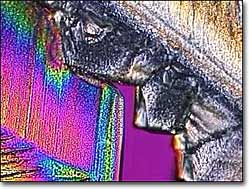Biological Buffer Movies

Biological Buffer Video No. 1 - Biological buffer crystallization is observed under polarized light illumination at a magnification of 20x in this video. Playing time is 5.4 seconds. Choose a playback format that matches your connection speed: 28.8k (modem), 56.6k (modem), or T1/Cable/DSL, or download this video clip in MPEG format (2.31 MB).
Biological Buffer Video No. 2 - Biological buffer crystallization is observed under polarized light illumination at a magnification of 10x in this video. Playing time is 8.5 seconds. Choose a playback format that matches your connection speed: 28.8k (modem), 56.6k (modem), or T1/Cable/DSL, or download this video clip in MPEG format (3.54 MB).
Many biosynthetic pathways are affected by the degree of acidity in the nucleus or cytoplasm in which they occur. In order for enzymatic reactions to proceed with the highest efficiency, the pH of the medium must be controlled, especially when these reactions are carried out in the laboratory. Control of pH is often provided by buffer systems, which help to maintain a specific, but usually narrow, range of pH values. As biochemical reactions are particularly sensitive to pH, these processes must be carefully monitored to ensure they are conducted in the appropriate environment. A majority of biological molecules, such as amino acids, proteins, nucleotides, sugars, and their intermediates contain functional groups that may be charged or neutral depending upon the hydrogen ion concentration. The ionization state of most molecules will affect their reactivities and govern both the kinetics (reaction rates) and equilibrium concentrations of chemical reactions.
Biochemical buffers are synthetic organic compounds that often contain non-carbon functional groups such as phosphate, amino, sulfhydryl, hydroxyl, and heterocyclic atoms capable of being ionized at physiological pH ranges. A buffer is an aqueous solution containing small quantities of dissolved compounds that help resist pH changes that occur as a result of the release of hydrogen and hydroxide ions during enzymatic or other chemical reactions. The buffer recrystallized in these time-lapse sequences is abbreviated HEPES, which is a sulfonic acid derivative of the nitrogen heterocycle piperazine. HEPES buffer systems are utilized primarily for freezing solutions of enzymes. Often, freeze-induced changes in acidity are a major factor causing inactivation of biological macromolecules during frozen storage.
